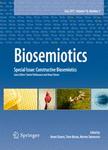版权所有:内蒙古大学图书馆 技术提供:维普资讯• 智图
内蒙古自治区呼和浩特市赛罕区大学西街235号 邮编: 010021

作者机构:Dactyl Fdn 64 Grand St New York NY 10013 USA US Dept State Fulbright Specialist Program Bur Educ & Cultural Affairs Washington DC 20520 USA
出 版 物:《BIOSEMIOTICS》 (生物符号学)
年 卷 期:2019年第12卷第1期
页 面:39-55页
核心收录:
学科分类:0303[法学-社会学] 0710[理学-生物学] 07[理学] 09[农学] 0712[理学-科学技术史(分学科,可授理学、工学、农学、医学学位)]
主 题:Saltationism Turing patterns Mimicry Pattern formation Genus Kallima Mimicry skepticism H F Nijhout
摘 要:Biological mimicry is regarded by many as a textbook illustration of Darwin s idea of evolution by random mutation followed by differential selection of reproductively fit specimens, resulting in gradual phenotypic change in a population. In this paper, I argue that some cases of so-called mimicry are probably merely look-a-likes and do not gain an advantage due to their similarity in appearance to something else. In cases where a similar appearance does provide a benefit, I argue that it is possible that these forms of mimicry were created in a single generation. An interpretive response to an appearance as a sign can make a new structure perform drastically differently in an environment. In such cases, Darwin s natural selection mechanism only helps to explain gradual the spread of these new forms, not the creation of them. I argue that biosemiosis should be regarded as a much more powerful mechanism for affecting evolutionary trajectories than the gradualist view allows. I focus on two cases of butterfly mimicry: the Viceroy (Nymphalidae: Limenitis archippus) and Monarch (Nymphalidae: Danaus plexippus) butterflies, supposed Mullerian mimics, and deadleaf mimic butterflies (Kallima).